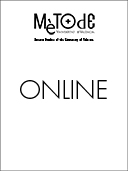The future of health communication: Innovating through partnerships
DOI:
https://doi.org/10.7203/metode.6.7096Paraules clau:
Health communication, health literacy, Ebola, vaccines, innovation Resum
Resum
The Preamble of the Constitution of the World Health Organization reminds us that «Informed opinion and active cooperation on the part of the public are of the utmost importance in the improvement of the health of the people» (Grad, 2002). Nonetheless, nearly seven decades later, the conditions under which people can be informed and actively participate in their health management in a meaningful way are being globally challenged. Drawing from experience in a variety of areas that I will delve into in this article, I remain a believer that we can marshal the necessary forces to advance the communication of health issues and create a base for a health-literate population to make smart(er), healthier decisions that advance health and well-being.
 Descàrregues
Descàrregues
 Referències
Referències
Columbia University Mailman School of Public Health. (n. d.). Public health oath. Retrieved from https://www.mailman.columbia.edu/about/mission-history/public-health-oath
Fenimore Cooper, J. (2000). The American democrat and other political writings. Washington: Regnery Publishing.
Gawande, A. (2010). The checklist manifesto: How to get things right. New York: Metropolitan Books.
Goldberg, A., Ratzan, S. C., Jacobson, K. L., & Parker, R. M. (2015). Adressing Ebola and other outbreaks: A communication checklist for global health leaders, policemakers, and practitioners. Journal of Health Communication, 20, 121–122. doi: 10.1080/10810730.2015.1007762
Grad, F. P. (2002). The preamble of the Constitution of the World Health Organization. Bulletin of the World Health Organization, 80, 981–984.
Gurman, T. A. (2015). Back to basics: Improving the conceptualization and operationalization of programmatic exposure in social and behavior change communication through conceptual models. Journal of Health Communication, 20(1), 1–3. doi: 10.1080/10810730.2015.1001699
Larson, H. J., Cooper. L. Z., Eskola, J., Katz, S. L., & Ratzan, S. C. (2011). Addressing the vaccine confidence gap. The Lancet, 378(9790), 526–535. doi: 10.1016/S0140-6736(11)60678-8
London School of Hygiene & Tropical Medicine. (2015, 23 November). Independent panel of global experts calls for critical reforms to prevent future pandemics. Retrieved from http://www.lshtm.ac.uk/newsevents/news/2015/ebola_report.html
Moon, S., Sridhar, D., Pate, M. A., Jha, A. K., Cinton, Ch., Delaunay, S., … Piot, P. (2015). Will Ebola change the game? Ten essential reforms before the next pandemic. The report of the Harvard-LSHTM independent panel on the global response to Ebola. The Lancet, 386, 2204–2221. doi: 10.1016/S0140-6736(15)00946-0
Pleasant, A. (2014). Advancing health literacy measurement: A pathway to better health and health system performance. Journal of Health Communication, 19(12), 1481–1496. doi: 10.1080/10810730.2014.954083
Pronovost, P., Needham, D., Berenholtz, S., Sinopoli, D., Chu, H., Cosgrove, S., ... Goeschel, C. (2006). An intervention to decrease catheter-related bloodstream infections in the ICU. New England Journal of Medicine, 355(26), 2725–2732. doi: 10.1056/NEJMoa061115
Ratzan, S. C. (1998). Mad cow crisis: Health and the public good. London: UCL Press.
Ratzan, S., & Parker, R. M. (2000). Introduction. In C. R. Selden, M. Zorn, S. Ratzan, & R. M. Parker (Eds.), National library of medicine current bibliographies in medicine: Health literacy. Bethesda, MD: National Institutes of Health, U.S. Department of Health and Human Services.
Ratzan, S. C., & Moritsugu, K. P. (2014). Ebola crisis – communication chaos we can avoid. Journal of Health Communication, 19(11), 1213–1215. doi: 10.1080/10810730.2014.977680
Spector, J. M., & Ratzan, S. C. (Eds.). (2012). Checklists for the last kilometer: Innovative strategies to ensure that life-saving commodities and information reach women and newborns at the moment of care. Report for Innovation Working Group. Retrieved from http://www.everywomaneverychild.org/images/Report1Checklists.pdf
The Lancet. (2012). Technologies for global health. The Lancet, 380(9840), 447. doi: 10.1016/S0140-6736(12)61273-2
United Nations. (n.d.). Goal 17: Revitalize the global partnership for sustainable development. Retrieved from http://www.un.org/sustainabledevelopment/globalpartnerships
United Nations. (2011). Political declaration of the high-level meeting of the General Assembly on the prevention and control of non-communicable diseases. Retrieved from http://www.un.org/ga/search/view_doc.asp?symbol=A/66/L.1
United Nations. (2015). Transforming our world: The 2030 agenda for sustainable development. Retrieved from https://sustainabledevelopment.un.org/post2015/transformingourworld
United Nations Population Fund. (2012). UN commission on life-saving commodities for women and children. Commisioner’s report. Retrieved from http://www.unfpa.org/sites/default/files/pub-pdf/Final%20UN%20Commission%20Report_14sept2012.pdf
World Health Organization. (2010). Every women, every child: Investing in our common future. Innovation Working Group Report. Retrieved from http://www.who.int/pmnch/activities/jointactionplan/100922_2_investing.pdf
World Health Organization. (2013). Global status report on road safety 2013. Retrieved from http://www.who.int/violence_injury_prevention/road_safety_status/2013/en
Descàrregues
Publicades
Com citar
-
Resum1492
-
PDF 1047
Número
Secció
Llicència
![]()
Tots els documents inclosos en OJS són d'accés lliure i propietat dels seus autors.
Els autors que publiquen en aquesta revista estan d'acord amb els següents termes:
- Els autors conserven els drets d'autor i garanteixen a la revista el dret a la primera publicació del treball, llicenciat baix una llicència de Reconeixement-NoComercial-SenseObraDerivada 4.0 Internacional de Creative Commons, que permet a altres compartir el treball amb un reconeixement de l'autoria del treball i citant la publicació inicial en aquesta revista.
- Es permet i s'anima els autors a difondre la versió definitiva dels seus treballs electrònicament a través de pàgines personals i institucionals (repositoris institucionals, pàgines web personals o perfils a xarxes professionals o acadèmiques) una vegada publicat el treball.





